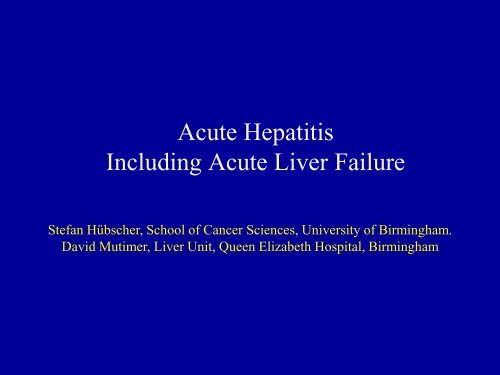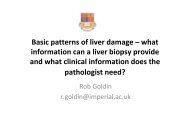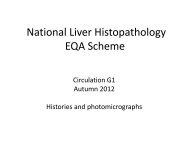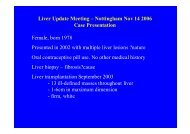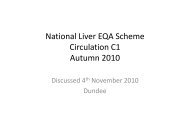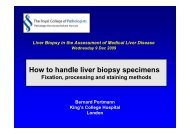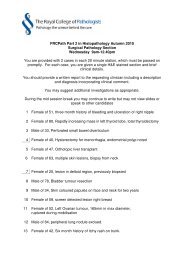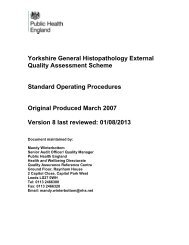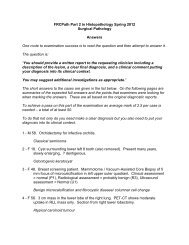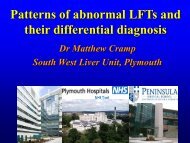Acute Hepatitis Including Acute Liver Failure
Acute Hepatitis Including Acute Liver Failure - Virtual Pathology at ...
Acute Hepatitis Including Acute Liver Failure - Virtual Pathology at ...
- No tags were found...
Create successful ePaper yourself
Turn your PDF publications into a flip-book with our unique Google optimized e-Paper software.
<strong>Acute</strong> <strong>Hepatitis</strong><br />
<strong>Including</strong> <strong>Acute</strong> <strong>Liver</strong> <strong>Failure</strong><br />
Stefan Hübscher, School of Cancer Sciences, University of Birmingham.<br />
David Mutimer, <strong>Liver</strong> Unit, Queen Elizabeth Hospital, Birmingham
<strong>Acute</strong> liver failure<br />
<strong>Acute</strong> <strong>Liver</strong> Injury
<strong>Acute</strong> <strong>Liver</strong> <strong>Failure</strong> (ALF)<br />
FHF and LOHF<br />
• FHF : fulminant hepatic failure<br />
“The development of encephalopathy within 8<br />
weeks of the onset of symptoms, without<br />
previous liver disease.”<br />
• LOHF : late onset hepatic failure<br />
“Encephalopathy appears after 8 weeks, but<br />
within 6 months of symptom onset.”<br />
‣ subacute hepatic necrosis<br />
‣ subacute hepatic failure
<strong>Acute</strong> <strong>Liver</strong> <strong>Failure</strong> (ALF)<br />
FHF and LOHF<br />
• FHF<br />
‣ paracetamol poisoning<br />
‣ coagulopathy + +<br />
‣ cerebral oedema + +<br />
‣ hypoglycaemia<br />
‣ may present before jaundice<br />
‣ potential for recovery with conservative care<br />
• LOHF<br />
‣ seronegative hepatitis (non-A, non-B)<br />
‣ coagulopathy +<br />
‣ ascites +<br />
‣ jaundice ++<br />
‣ renal failure<br />
‣ conservative care fails, transplant indicated
<strong>Acute</strong> <strong>Liver</strong> <strong>Failure</strong> Admissions<br />
Birmingham <strong>Liver</strong> Unit 1987-2007<br />
1000<br />
800<br />
600<br />
400<br />
200<br />
0<br />
Seronegative<br />
AFLP/HELLP<br />
Other drug/toxin<br />
Miscellaneous<br />
POD<br />
Viral<br />
AVOD<br />
Wilsons<br />
Budd Chiari
<strong>Acute</strong> <strong>Liver</strong> Injury<br />
Patient Management<br />
• Aetiology<br />
• Severity<br />
• Prognosis
<strong>Acute</strong> <strong>Liver</strong> Injury<br />
Establishing the Aetiology<br />
History<br />
• drug exposure<br />
‣ prescription<br />
‣ non-prescription<br />
‣ herbal<br />
• psychiatric and psychosocial issues<br />
• exposure to hepatitis viruses<br />
‣ travel (hepatitis A or E)<br />
‣ sex (hepatitis B)<br />
‣ blood exposure (hepatitis C or B)<br />
Examination<br />
• absence of signs of chronic liver disease<br />
• liver size
<strong>Acute</strong> <strong>Liver</strong> Injury<br />
Establishing the Aetiology<br />
Blood tests<br />
• routine biochemistry<br />
‣hyperacute (high transaminases, lower bilirubin)<br />
• paracetamol, ischaemia, hepatitis B<br />
‣subacute (lower transaminases, higher bilirubin)<br />
• seronegative hepatitis<br />
‣Wilson’s disease (low alkaline phosphatase)<br />
• paracetamol detection<br />
• viral serology<br />
‣IgM antibodies to HAV, HBV, HEV<br />
• liver immunology<br />
‣autoantibodies, immunoglobulins
<strong>Acute</strong> <strong>Liver</strong> Injury<br />
Establishing the Aetiology<br />
Imaging<br />
• ultrasound<br />
‣ liver size and texture<br />
‣ spleen size<br />
‣ ascites<br />
‣ oedematous gall bladder<br />
‣ infiltration<br />
• ? CT scan<br />
Biopsy<br />
• how will the histology influence management?<br />
• problems<br />
• bleeding<br />
• cerebral oedema<br />
• misinterpretation of histology (by the pathologist)<br />
• clinician over-reliance on histological diagnosis<br />
• delays definitive treatment
<strong>Acute</strong> <strong>Liver</strong> Injury<br />
Establishing the Severity & Prognosis<br />
• Aetiology<br />
‣ paracetamol poisoning has unique prognostic criteria<br />
‣ seronegative hepatitis has poor prognosis<br />
• Duration of illness<br />
• Clinical features<br />
‣ shrinking liver<br />
‣ ascites<br />
• Biochemistry limited value<br />
• Coagulation important
Case 1
Case 1<br />
• 52 year old Caucasian male<br />
• GP referral to surgeons with “obstructive jaundice”<br />
• US and MRCP (stones in gall bladder, spleen 13 cm)<br />
• liver biochemistry<br />
• refer to physicians (seen 2 weeks later in clinic)<br />
• ALT 1263, bilirubin 250, INR 1.1 (and stable for 2 weeks)<br />
• viral serology negative<br />
• immunology<br />
• antinuclear antibody and anti smooth muscle antibody positive<br />
• slightly elevated immunoglobulins<br />
• diagnosis: aetiology and severity?<br />
• acute autoimmune hepatitis (can be underlying chronic damage)<br />
• no evidence of liver failure (not incipient)<br />
• liver biopsy
<strong>Liver</strong> Biopsy in <strong>Acute</strong> <strong>Hepatitis</strong><br />
Histological Approach<br />
1. Is this acute or chronic damage?<br />
2. How severe is the damage?<br />
3. What is the cause?
Case 1
Case 1
Case 1
Case 1 - ductular reaction<br />
CK7 immunostaining
Case 1
Case 1
Case 1
Case 1 (PAS-diastase)
Case 1 (PAS-diastase)
<strong>Acute</strong> <strong>Hepatitis</strong><br />
Hepatocyte Proliferation (Ki 67 immunostaining)
Case 1 (Perl’s)
Case 1 (HVG)
Case 1<br />
Histological Findings<br />
• Portal inflammation<br />
– mainly mononuclear with plasma cells<br />
• Bile ductular reaction<br />
• Spotty lobular inflammation, associated with<br />
– Ballooning<br />
– Acidophil body formation<br />
– Lobular disarray<br />
– Small foci of confluent necrosis<br />
– Bilirubinostasis (mild)
Case 1<br />
Diagnosis<br />
• <strong>Acute</strong> hepatitis with spotty necrosis and focal<br />
confluent necrosis<br />
• In keeping with autoimmune hepatitis
Autoimmune <strong>Hepatitis</strong> - <strong>Acute</strong> Presentation<br />
Incidence & Diagnostic Criteria<br />
30- 40% of cases present as acute hepatitis /acute liver failure<br />
(Czaja & Freese 2002, Lohse 2011)<br />
Increasing prevalence of AIH as a cause for acute liver failure<br />
(Fujiwara 2011)<br />
• ? May reflect improved recognition<br />
Autoantibodies unreliable in the diagnosis of acute AIH<br />
• Autoantibodies and hypergammaglobulinaemia may not be present at the time<br />
of presentation with acute AIH (Lohse 2011)<br />
• Autoantibodies present in up to 40% of patients with other causes of acute<br />
liver failure - e.g viral or drug-induced (Bernal 2007, Reuben 2010)
Autoimmune <strong>Hepatitis</strong> - <strong>Acute</strong> Presentation<br />
Histological Features<br />
<strong>Acute</strong> presentation of chronic liver disease<br />
• 14-35% have features of chronic hepatitis (Fujiwara 2011,<br />
Yasui 2011)<br />
• 10-95% have bridging fibrosis or cirrhosis (Nikias 1994,<br />
Burgart 1995, Miyake 2010, Fujiwara 2011)
Autoimmune <strong>Hepatitis</strong> - <strong>Acute</strong> Presentation<br />
Histological Features<br />
<strong>Acute</strong> hepatitis (with no signs of chronic liver disease)<br />
(Hofer 2006, Te 1997, Singh 2002, Hofer 2006, Ichai 2007, Miyake 2010, Fujiwara 2011,<br />
Stravitz 2011, Susuki 2011, Yasui 2011)<br />
– Classical features of acute lobular hepatitis<br />
– Mainly centrilobular distribution (central perivenulitis)<br />
• Often associated with centrilobular necrosis<br />
– Some cases initially have little or no portal inflammation, before<br />
subsequently progressing to more classical features of chronic AIH
Case 1- outcome<br />
• Treatment with corticosteroids and azathioprine<br />
• Prompt resolution of liver dysfunction<br />
• Negativity of autoantibodies<br />
• Reduction of immunosuppression<br />
‣ mild biochemical relapse<br />
‣ reappearance of autoantibodies
Case 2<br />
• 67 year old Caucasian male<br />
• 1 to 2 week history of jaundice and abdominal distension<br />
• ALT 1011, bilirubin 220, INR 2.0<br />
• viral serology negative<br />
• autoantibodies negative, immunoglobulins normal<br />
• US scan<br />
‣ small liver<br />
‣ ascites ++<br />
‣ spleen not enlarged<br />
• Diagnosis: aetiology and severity<br />
‣ acute seronegative hepatitis<br />
‣ severe (small liver with ascites)<br />
‣ poor prognosis for recovery<br />
• <strong>Liver</strong> biopsy
Case 2<br />
LIVER BIOPSY
<strong>Liver</strong> Biopsy – Case 2<br />
Histological Findings<br />
• Recent panacinar necrosis (multi-acinar necrosis)<br />
– Periportal ductular reaction<br />
– No surviving hepatocytes<br />
Comment<br />
• Likely to be a manifestation of severe acute hepatitis<br />
• No obvious aetiological pointers
Case 2 – outcome<br />
• Mild encephalopathy 1 week post-admission<br />
• Listed “superurgent” for transplantation<br />
• Transplanted<br />
• Excellent recovery<br />
‣ no early recurrence<br />
• Continues immunosuppression
Case 2<br />
HEPATECTOMY SPECIMEN
Case 2. Macroscopic Appearances<br />
Shrunken liver, weight 700g. Wrinkled capsular surface
Case 2<br />
Macroscopic Appearances
Could this be cirrhotic?
Recent Post-Necrotic Collapse versus Longstanding Fibrosis<br />
Use Of Connective Tissue Stains<br />
Stain<br />
Material<br />
Demonstrated<br />
Distribution In<br />
Normal <strong>Liver</strong><br />
Changes In <strong>Liver</strong> Disease<br />
Reticulin<br />
Type III collagen<br />
fibres<br />
Portal tracts,<br />
hepatic sinusoids<br />
Collapse of reticulin<br />
framework in areas of<br />
recent liver cell necrosis.<br />
(few days)<br />
Haematoxylin<br />
Van Gieson<br />
Type I collagen fibres<br />
Portal tracts, walls<br />
of hepatic veins<br />
Increased in hepatic fibrosis<br />
(weeks/months)<br />
Orcein Elastic fibres Portal tracts,<br />
walls of hepatic<br />
veins<br />
Found in long-standing<br />
fibrosis/cirrhosis<br />
(months/years)
Other Changes Seen in Areas of Parenchymal Necrosis<br />
Congestion<br />
May suggest a vascular problem – e.g. venous outflow obstruction
Other Changes Seen in Areas of Parenchymal Necrosis<br />
PAS-diastase CD 68<br />
Ceroid Pigment Laden Macrophages
Hepatectomy Specimen – Case 2<br />
Histological Findings<br />
• Large areas of panacinar necrosis (multi-acinar necrosis)<br />
– Periportal ductular reaction<br />
– Inflammation of hepatic veins<br />
• Surviving areas of liver parenchyma<br />
– Nodular regeneration<br />
– Severe bilirubinostasis<br />
– Zonal/bridging necrosis<br />
– Little inflammation
Diagnosis<br />
Hepatectomy Specimen – Case 2<br />
• Severe acute hepatitis with multiacinar necrosis<br />
(submassive hepatic necrosis)<br />
• No strong aetiological pointers ( “seronegative<br />
hepatitis”)
Role of <strong>Liver</strong> Biopsy in <strong>Acute</strong> <strong>Hepatitis</strong><br />
• Many of the classical morphological studies of acute hepatitis were carried<br />
out before the main causes had been discovered<br />
• Most cases of acute hepatitis now diagnosed on the basis of clinical,<br />
biochemical and serological findings and liver biopsy is rarely indicated<br />
• <strong>Liver</strong> biopsy may still be carried out in cases where the clinical presentation<br />
is atypical or the cause is uncertain<br />
– Confirm diagnosis of acute hepatitis<br />
– Determine disease severity<br />
– Identify possible aetiological factors (including cases of acute liver injury not<br />
related to hepatitis)
<strong>Liver</strong> Biopsy in <strong>Acute</strong> <strong>Hepatitis</strong><br />
Histological Approach<br />
1. Is this acute or chronic damage?<br />
• severe acute hepatitis versus<br />
• decompensated chronic liver disease<br />
• acute exacerbation of chronic liver disease (e.g. autoimmune hepatitis,<br />
hepatitis A/E superimposed on underlying cirrhosis)<br />
2. How severe is the damage?<br />
3. What is the cause?
<strong>Acute</strong> versus Chronic Damage<br />
Severe <strong>Acute</strong> <strong>Hepatitis</strong> (e.g. case 2)<br />
• Areas of bridging necrosis & nodular regeneration can resemble changes occurring<br />
in cirrhosis<br />
• Areas of multiacinar necrosis can resemble inflamed fibrous septa in cirrhosis<br />
<strong>Acute</strong> versus Chronic Damage - Helpful pointers<br />
• Clinical context<br />
• Identification of normal vascular relationships<br />
• Use of connective tissue stains to determine age of lesions
<strong>Liver</strong> Biopsy in <strong>Acute</strong> <strong>Hepatitis</strong><br />
Histological Approach<br />
1. Is this acute or chronic damage?<br />
2. How severe is the damage?<br />
3. What is the cause?
<strong>Liver</strong> Cell Death in <strong>Acute</strong> <strong>Hepatitis</strong><br />
Pattern of Cell Death<br />
Histological Features<br />
Spotty necrosis<br />
Apoptosis of individual hepatocytes (acidophil bodies)<br />
Confluent necrosis<br />
(zone 3)<br />
Bridging necrosis<br />
Panacinar necrosis<br />
Loss of groups of adjacent liver cells<br />
Confluent necrosis linking vascular structures<br />
(central-central or central-portal bridging)<br />
Loss of hepatocytes in an entire acinus<br />
Multiacinar necrosis<br />
Panacinar necrosis involving several adjacent acini<br />
• Apoptosis > necrosis (in mild forms)<br />
• Severe necro-inflammatory lesions uneven in distribution<br />
‣ Sampling variability in liver biopsies<br />
‣ Extent of hepatocyte necrosis predictive of poor outcome in some studies (Katoonizadeh<br />
2006, Miraglia 2006, Rastogi 2011)
<strong>Liver</strong> Biopsy in <strong>Acute</strong> <strong>Hepatitis</strong><br />
Histological Approach<br />
1. Is this acute or chronic damage?<br />
2. How severe is the damage?<br />
3. What is the cause?
<strong>Acute</strong> <strong>Hepatitis</strong> - Common Causes<br />
1. Viral<br />
• <strong>Hepatitis</strong> viruses – A,B,C,D, E<br />
• Other viruses – e.g. CMV, EBV<br />
2. Drugs<br />
3. Autoimmune<br />
4. Unknown<br />
• Seronegative hepatitis (“non-A, non-B, non-C hepatitis”)<br />
• Accounts for 40% of patients in the U.K presenting with<br />
severe acute hepatitis leading to acute liver failure (Ichai 2008,<br />
Bernal 2010)
<strong>Acute</strong> <strong>Hepatitis</strong> - Aetiological Considerations<br />
<strong>Liver</strong> biopsy rarely identifies a previously unsuspected aetiology<br />
• Biopsies mostly obtained from people in whom main recognised causes have been<br />
excluded (“seronegative hepatitis”)<br />
• Biopsy sometimes provides pointers to a previously unsuspected aetiology<br />
Aetiology<br />
Suggestive Histological features<br />
Drugs • Disproportionately severe / well-circumscribed necrosis<br />
(relatively little inflammation – lobular and/or portal)<br />
• Unusual patterns of necrosis - e.g periportal (zone 1) necrosis<br />
• Unusually prominent cholestasis<br />
• Eosinophils, granulomas<br />
Autoimmune<br />
hepatitis<br />
(Abe 2007, Fujiwara 2008,<br />
Stravitz 2011, Yasui 2011)<br />
• Plasma cell rich portal infiltrate (also seen in hepatitis A)<br />
• Prominent periportal inflammation (interface hepatitis)<br />
• Lymphoid aggregates<br />
• Prominent centrilobular inflammation (“central perivenulitis”)
<strong>Acute</strong> <strong>Hepatitis</strong> - Aetiological Considerations<br />
<strong>Liver</strong> biopsy may identify a cause of acute liver injury not due to acute hepatitis<br />
• Decompensated chronic liver disease (e.g. Wilson’s disease)<br />
• Another cause of acute liver damage (e.g. ischaemic hepatitis, severe<br />
alcoholic hepatitis, paracetamol toxicity)<br />
• Hepatic infiltration (usually lymphoma, less commonly carcinoma)<br />
– <strong>Liver</strong> usually enlarged
Saturday 22 October 2011


